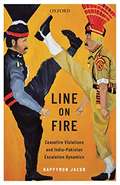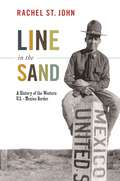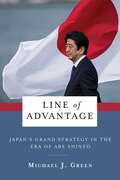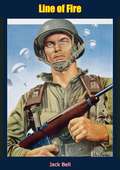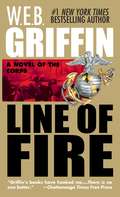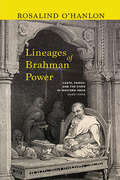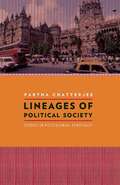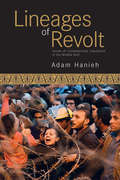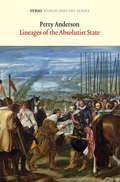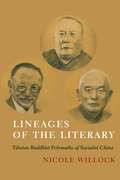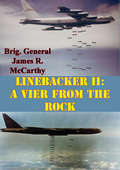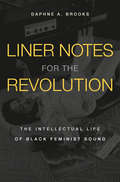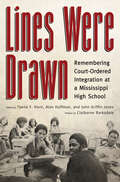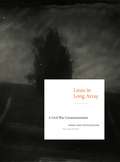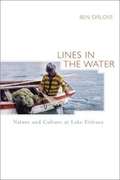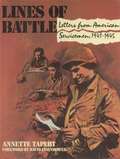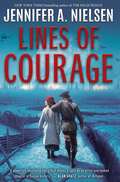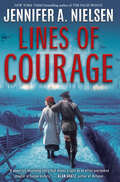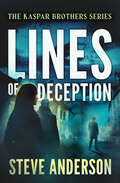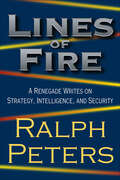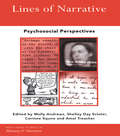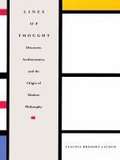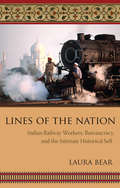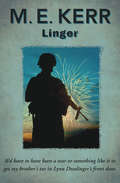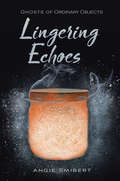- Table View
- List View
Line On Fire: Ceasefire Violations And India-pakistan Escalation Dynamics (Oxford International Relations In South Asia)
by Sumit Ganguly E. Sridharan Happymon JacobThe India–Pakistan border in Jammu & Kashmir has witnessed repeated ceasefire violations (CFVs) over the past decade. As relations between India and Pakistan have deteriorated, CFVs have increased exponentially. It is imperative to gain a deeper understanding of these violations owing to their potential to not only cause a crisis but also escalate an ongoing one. Line on Fire, part of the Oxford International Relations in South Asia series, postulates that the incorrect diagnosis of the reasons behind CFVs has led to wrong policies being adopted by both India and Pakistan to deal with the recurrent violations. Using fresh empirical data and first-hand accounts, the volume attempts to understand the reason why CFVs continue to take place between India and Pakistan despite consistent efforts to reduce the tension between the two nations. In doing so, it recontextualizes and enriches the prevailing arguments in contemporary literature on escalating dynamics and unenduring ceasefire agreements between the two South Asian nuclear rivals.
Line in the Sand: A History of the Western U.S.-Mexico Border (America in the World #11)
by Rachel St. JohnThe first transnational history of the U.S.-Mexico borderLine in the Sand details the dramatic transformation of the western U.S.-Mexico border from its creation at the end of the Mexican-American War in 1848 to the emergence of the modern boundary line in the first decades of the twentieth century. In this sweeping narrative, Rachel St. John explores how this boundary changed from a mere line on a map to a clearly marked and heavily regulated divide between the United States and Mexico. Focusing on the desert border to the west of the Rio Grande, this book explains the origins of the modern border and places the line at the center of a transnational history of expanding capitalism and state power in the late nineteenth and early twentieth centuries.Moving across local, regional, and national scales, St. John shows how government officials, Native American raiders, ranchers, railroad builders, miners, investors, immigrants, and smugglers contributed to the rise of state power on the border and developed strategies to navigate the increasingly regulated landscape. Over the border's history, the U.S. and Mexican states gradually developed an expanding array of official laws, ad hoc arrangements, government agents, and physical barriers that did not close the line, but made it a flexible barrier that restricted the movement of some people, goods, and animals without impeding others. By the 1930s, their efforts had created the foundations of the modern border control apparatus.Drawing on extensive research in U.S. and Mexican archives, Line in the Sand weaves together a transnational history of how an undistinguished strip of land became the significant and symbolic space of state power and national definition that we know today.
Line of Advantage: Japan’s Grand Strategy in the Era of Abe Shinzō (Contemporary Asia in the World)
by Michael GreenNo other country has devised a grand strategy for managing China’s rising economic and military power as deliberately or successfully as Japan. Seeking to counter Chinese ambitions toward regional hegemony, Japan has taken an increasingly assertive role in East Asia and the world. During the tenure of Prime Minister Abe Shinzo, the country pursued closer security cooperation with the United States and other democracies, established a more centralized national defense system, and advanced rules and norms to preserve the open regional order in the Indo-Pacific that is crucial to its prosperity and survival—all while managing an important economic relationship with China.In Line of Advantage, Michael J. Green provides a groundbreaking and comprehensive account of Japan’s strategic thinking under Abe. He explains the foundational logic and the worldview behind this approach, from key precedents in Japanese history to the specific economic, defense, and diplomatic priorities shaping contemporary policy toward China, the United States, the two Koreas, and the Indo-Pacific region. Drawing on two decades of access to Abe and other Japanese political, military, and business leaders, Green provides an insider’s perspective on subjects such as how Japan pursued competition with China without losing the benefits of economic cooperation. Assessing the strengths and weaknesses of Japan’s new active role, Line of Advantage sheds new light on a period with profound implications for the future of U.S. competition with China and international affairs in Asia more broadly.
Line of Fire
by Jack BellTHE STORY OF WORLD WAR II’S LOWEST COMMON DENOMINATOR—THE FIGHTING MANOriginally published in 1948, this is the fascinating account of U.S. soldiers fighting in East Asia and Europe, as seen firsthand by an American journalist, Jack Bell of the Chicago Daily News.“Jack Bell spent his time with the fighting men, usually where the fighting was the thickest. He knew the troops and lived with them. He was the kind of a correspondent who would patrol the frontal areas, get voluminous motes, go back to his typewriter and write enough stuff to fill his requirements for a week, then go out again for another basketful of names and hometowns.“He saw and knew the war as it really was—the machine gunner sweating out the next attack; the advancing BAR man clinging closely to a stone wall; the lonely man on an outpost listening with every pore of his body; the exhilaration and excitement of intense firing and fighting and the depressing feeling that came with surveying the killed and wounded in the silence that followed. He knew all of it and much more. He knew the people that fought it, their fear, their worries, and their moments of greatness. And this, finally, is the essence of war. For it is a composite of men, gun crews, air crews, seamen, and thousands of small fighting teams, all of whom regardless of their origins and fears do their jobs when the chips are down. It is these things rather than broad arrows on bright maps with thumb smudged evidences of staff cerebrations that is war. And this was Jack Bell’s war.”—James M. Gavin
Line of Fire (Corps #5)
by W.E.B. GriffinLine of Fire brings to life a desperate mission of World War II that captures the drama and courage of the men who fought it. Two Marines, reporting on Japanese air activity, are trapped on a small Coastwatcher island. A special rescue team is assembled to save them--under enemy gunsight. It is am exciting and powerful story of real heroism that only W.E.B. Griffin could tell...
Lineages of Brahman Power: Caste, Family, and the State in Western India, 1600–1900 (SUNY series in Hindu Studies)
by Rosalind O'HanlonTraces the role that western India's influential Brahman communities played in shaping India's modern caste system.Western India's Brahman communities have played a key role in the shaping of India's modern caste system. In Lineages of Brahman Power, Rosalind O'Hanlon focuses on their rise to power between the seventeenth and nineteenth centuries, exploring the ways in which some Brahman intellectuals sought to defend the hierarchies of caste against the social changes of the early modern era while others looked for compromise. Drawing on Marathi vernacular sources, O'Hanlon also examines the household, family, and lineage as key sites for Brahman accumulation of skills and cultural capital. This approach also reveals Brahman identity itself as contested, as Brahman subcastes competed with each other not only for service positions and state patronage but also to define who could actually be considered a Brahman, and of what kind. This focus on Brahman social history is novel, in that most historians focus on Brahman power as emerging out of their religious prestige and dominance of intellectual and literary cultures. The emphasis on Brahman identity itself as complex and internally contested also helps to avoid essentializing Brahman power as always and everywhere the same.
Lineages of Political Society: Studies in Postcolonial Democracy (Cultures of History)
by Partha ChatterjeePartha Chatterjee, a pioneering theorist known for his disciplinary range, builds on his theory of "political society" and reinforces its salience to contemporary political debate. Dexterously incorporating the concerns of South Asian studies, postcolonialism, the social sciences, and the humanities, Chatterjee broadly critiques the past three hundred years of western political theory to ask, Can democracy be brought into being, or even fought for, in the image of Western democracy as it exists today? Using the example of postcolonial societies and their political evolution, particularly communities within India, Chatterjee undermines the certainty of liberal democratic theory in favor of a realist view of its achievements and limitations. Rather than push an alternative theory, Chatterjee works solely within the realm of critique, proving political difference is not always evidence of philosophical and cultural backwardness outside of the West. Resisting all prejudices and preformed judgments, he deploys his trademark, genre-bending, provocative analysis to upend the assumptions of postcolonial studies, comparative history, and the common claims of contemporary politics.
Lineages of Revolt
by Adam HaniehWhile the outcomes of the tumultuous uprisings that continue to transfix the Arab world remain uncertain, the root causes of rebellion persist. Drawing upon extensive empirical research, Lineages of Revolt tracks the major shifts in the region's political economy over recent decades. In this illuminating and original work, Adam Hanieh explores the contours of neoliberal policies, dynamics of class and state formation, imperialism and the nature of regional accumulation, the significance of Palestine and the Gulf Arab states, and the ramifications of the global economic crisis. By mapping the complex and contested nature of capitalism in the Middle East, the book demonstrates that a full understanding of the uprisings needs to go beyond a simple focus on "dictators and democracy."
Lineages of the Absolutist State
by Perry AndersonThe political nature of Absolutism has long been a subject of controversy within historical materialism. Developing considerations advanced in Passages from Antiquity to Feudalism, this book situates the Absolutist states of the early modern epoch against the prior background of European feudalism. It is divided into two parts. The first discusses the overall structures of Absolutism as a state-system in Western Europe, from the Renaissance onwards. It then looks in turn at the trajectory of each of the specific Absolutist states in the dominant countries of the West--Spain, France, England and Sweden, set off against the case of Italy, where no major indigenous Absolutism developed. The second part of the work sketches a comparative prospect of Absolutism in Eastern Europe. The peculiarities, as well as affinities, of Eastern Absolutism as a distinct type of royal state, are examined. The variegated monarchies of Prussia, Austria and Russia are surveyed, and the lessons asked of the counter-example of Poland. Finally, the structureof the Ottoman Empire in the Balkans is taken as an external gauge by which the singularity of Absolutism as a European phenomenon is assessed. The work ends with some observations on the special position occupied by European development within universal history, which draws themes from both Passages from Antiquity to Feudalism andLineages of the Absolutist State together into a single argument--within their common limits--as materials for debate.
Lineages of the Literary: Tibetan Buddhist Polymaths of Socialist China
by Nicole WillockIn the aftermath of the cataclysmic Maoist period, three Tibetan Buddhist scholars living and working in the People’s Republic of China became intellectual heroes. Renowned as the “Three Polymaths,” Tséten Zhabdrung (1910–1985), Mugé Samten (1914–1993), and Dungkar Lozang Trinlé (1927–1997) earned this symbolic title for their efforts to keep the lamp of the Dharma lit even in the darkest hour of Tibetan history.Lineages of the Literary reveals how the Three Polymaths negotiated the political tides of the twentieth century, shedding new light on Sino-Tibetan relations and Buddhism during this turbulent era. Nicole Willock explores their contributions to reviving Tibetan Buddhism, expanding Tibetan literary arts, and pioneering Tibetan studies as an academic discipline. Her sophisticated reading of Tibetan-language sources vivifies the capacious literary world of the Three Polymaths, including autobiography, Buddhist philosophy, poetic theory, and historiography. Whereas prevailing state-centric accounts place Tibetan religious figures in China in one of two roles, collaborator or resistance fighter, Willock shows how the Three Polymaths offer an alternative model of agency. She illuminates how they by turns safeguarded, taught, and celebrated Tibetan Buddhist knowledge, practices, and institutions after their near destruction during the Cultural Revolution.An interdisciplinary work spanning religious studies, history, literary studies, and social theory, Lineages of the Literary offers new insight into the categories of religion and the secular, the role of Tibetan Buddhist leaders in modern China, and the contested ground of Tibet.
Linebacker II: A View From The Rock [Illustrated Edition] (USAF Southeast Asia Monograph Series #6)
by Brig. General James R. McCarthy Lt.-Col. George B. AllisonWith 30 illustrationsThis is a narrative drawn from the era of the Southeast Asian conflict, detailing a unique event in that lengthy struggle. The event was called LINEBACKER II, a nickname like thousands of others, used to identify an operation, project, or mission associated with military affairs. It so differed from the many others, however, in its execution and outcome, that it stands alone. For the first time in contemporary warfare, heavy jet bombers were employed in their designed role to conduct extended strategic operations against the warmaking capacity of a hostile nation.This monograph tells part of the story of Strategic Air Command's participation in LINEBACKER II. In so doing, it addresses the efforts of a complex mixture of Air Force and sister service operations, with all services working in concert towards a common goal. Rather than develop a complete chronology or blow-by-blow account, which are matters of record in other works, the campaign is pursued more from the personal perspective.Herein is described the impact of LINEBACKER II on those in command, plus those in operations, maintenance and support who undergirded the effort, and the crewmembers. The narrative tells how they successfully met a staggering challenge. There was no book to follow. In only eleven days of intense combat operations they wrote their own book as they supported and flew the missions.In reviewing their story we find insight as to why the nation and the military need this caliber of people, who stepped forward when the need arose, demonstrated superior leadership, determination, and resiliency, did the job, and then dispersed into the more normal patterns of life. Many have since retired or separated from active service. Yet, it is clear that the ultimate well-being of our military structure in society must hinge on the continuing presence of this breed of people. Theirs was an achievement born of great ability and courage, and deserving of great honor.
Liner Notes for the Revolution: The Intellectual Life of Black Feminist Sound
by Daphne A. BrooksAn award-winning Black feminist music critic takes us on an epic journey through radical sound from Bessie Smith to Beyoncé. Daphne A. Brooks explores more than a century of music archives to examine the critics, collectors, and listeners who have determined perceptions of Black women on stage and in the recording studio. How is it possible, she asks, that iconic artists such as Aretha Franklin and Beyoncé exist simultaneously at the center and on the fringe of the culture industry? Liner Notes for the Revolution offers a startling new perspective on these acclaimed figures—a perspective informed by the overlooked contributions of other Black women concerned with the work of their musical peers. Zora Neale Hurston appears as a sound archivist and a performer, Lorraine Hansberry as a queer Black feminist critic of modern culture, and Pauline Hopkins as America’s first Black female cultural commentator. Brooks tackles the complicated racial politics of blues music recording, song collecting, and rock and roll criticism. She makes lyrical forays into the blues pioneers Bessie Smith and Mamie Smith, as well as fans who became critics, like the record-label entrepreneur and writer Rosetta Reitz. In the twenty-first century, pop superstar Janelle Monae’s liner notes are recognized for their innovations, while celebrated singers Cécile McLorin Salvant, Rhiannon Giddens, and Valerie June take their place as cultural historians. With an innovative perspective on the story of Black women in popular music—and who should rightly tell it—Liner Notes for the Revolution pioneers a long overdue recognition and celebration of Black women musicians as radical intellectuals.
Lines Were Drawn: Remembering Court-Ordered Integration at a Mississippi High School
by Claiborne BarksdaleLines Were Drawn looks at a group of Mississippi teenagers whose entire high school experience, beginning in 1969, was under federal court-ordered racial integration. Through oral histories and other research, this group memoir considers how the students, despite their markedly different backgrounds, shared a common experience that greatly influences their present interactions and views of the world—sometimes in surprising ways. The book is also an exploration of memory and the ways in which the same event can be remembered in very different ways by the participants. The editors (proud members of Murrah High School's Class of 1973) and more than fifty students and teachers address the reality of forced desegregation in the Deep South from a unique perspective—that of the faculty and students who experienced it and made it work, however briefly. The book tries to capture the few years in which enough people were so willing to do something about racial division that they sacrificed immediate expectations to give integration a true chance. This period recognizes a rare moment when the political will almost caught up with the determination of the federal courts to finally do something about race. Because of that collision of circumstances, southerners of both races assembled in the public schools and made integration work by coming together, and this book seeks to capture those experiences for subsequent generations.
Lines in Long Array: A Civil War Commemoration: Poems and Photographs, Past and Present
by David C. Ward Frank H. Goodyear IIILines in Long Array demonstrates the enduring impact of the Civil War on American culture by presenting poems and photographs from both the past and present, including 12 wholly new poems by contemporary poets created especially for this volume.Includes previously unpublished poetry by Eavan Boland, Geoffrey Brock, Nikki Giovanni, Jorie Graham, John Koethe, Yusef Komunyakaa, Paul Muldoon, Steve Scafidi, Jr., Michael Schmidt, Dave Smith, Tracy K. Smith, and C. D. Wright. Also includes historic poems by Ethel Lynn Beers, Ambrose Bierce, George H. Boker, Emily Dickinson, Frances Ellen Watkins Harper, Oliver Wendell Holmes Sr., Julia Ward Howe, Herman Melville, Francis Orray Ticknor, Henry Timrod, Walt Whitman, and John Greenleaf Whittier.From the Trade Paperback edition.
Lines in the Water: Nature and Culture at Lake Titicaca
by Benjamin S. OrlovePart ethnography, part natural history, part memoir, Ben Orlove's book reflects on the changes that have taken place over 30 years in the fishing villages along the shores of Lake Titicaca.
Lines of Battle: Letters from American Servicemen, 1941-1945
by Annette TapertLetters from American Servicemen 1941-1945.
Lines of Courage
by Jennifer A. NielsenJennifer A. Nielsen, award-winning author of A Night Divided and Rescue, artfully weaves together the stories of five kids living through World War I, each of whom holds the key to the others' futures... if they are lucky -- and brave -- enough to find each other. <p><p> World War I stretches its cruel fingers across Europe, where five young people, each from different backgrounds and nations, face the terror of battle, the deprivations of hunger, and all the awful challenges of war. <p><p> Felix, from Austria-Hungary, longs for the bravery to resist Jewish deportations before his own family can be taken. <p><p> Kara, from Britain, dreams of someday earning her Red Cross pin and working as a nurse -- or even a doctor. <p><p> Juliette, of France, hopes her family can remain knitted together, despite her father's imprisonment, as the war's longest battle stretches on and on. <p><p> Elsa, from Germany, hopes her homing pigeon might one day bring her a friend from out of the chaos. <p><p> And Dimitri, of Russia, wants only to survive the front, where he's been sent with no weapon. <p><p> None of them will find exactly what they want. But the winds of fate may cross their paths to give each of them just what they need. And in this remarkable exploration of World War I by critically acclaimed author Jennifer A. Nielsen, they will discover that friendship and courage can light the way through the most frightening of nights.
Lines of Courage
by Jennifer A. NielsenJennifer A. Nielsen, award-winning author of A Night Divided and Rescue, artfully weaves together the stories of five kids living through World War I, each of whom holds the key to the others' futures... if they are lucky -- and brave -- enough to find each other."A powerful, absorbing story that shines a light on an often overlooked chapter in human history." -- Alan Gratz, #1 New York Times bestselling author of RefugeeWorld War I stretches its cruel fingers across Europe, where five young people, each from different backgrounds and nations, face the terror of battle, the deprivations of hunger, and all the awful challenges of war.Felix, from Austria-Hungary, longs for the bravery to resist Jewish deportations before his own family can be taken.Kara, from Britain, dreams of someday earning her Red Cross pin and working as a nurse -- or even a doctor.Juliette, of France, hopes her family can remain knitted together, despite her father's imprisonment, as the war's longest battle stretches on and on.Elsa, from Germany, hopes her homing pigeon might one day bring her a friend from out of the chaos.And Dimitri, of Russia, wants only to survive the front, where he's been sent with no weapon.None of them will find exactly what they want. But the winds of fate may cross their paths to give each of them just what they need. And in this remarkable exploration of World War I by critically acclaimed author Jennifer A. Nielsen, they will discover that friendship and courage can light the way through the most frightening of nights.
Lines of Deception (The Kaspar Brothers)
by Steve AndersonA West German nightclub owner goes behind the Iron Curtain on a desperate mission to save his brother, in this Cold War thriller by the author of Lost Kin.West Germany, 1949. Former actor Max Kaspar suffered greatly in the Second World War. Now he owns a nightclub in Munich—and occasionally lends a hand to the newly formed CIA. Meanwhile, his brother Harry has ventured beyond the Iron Curtain to rescue an American scientist. When Harry is also taken captive, Max resolves to locate his brother at all costs. The last thing he expects is for Harry to go rogue. Max&’s treacherous quest takes him to Vienna and Prague to Soviet East Germany and Communist Poland. Along the way, dangerous operators from Harry&’s past join the pursuit: his former lover Katarina, who&’s working for the Israelis, and former Nazi Hartmut Dietz, now an agent of East German intelligence. But can anyone be trusted? Even the American scientist Stanley Samaras may not be the hero Harry had believed him to be . . .
Lines of Fire: A Renegade Writes on Strategy, Intelligence, and Security
by Ralph PetersThe New York Times–bestselling military analyst offers a collection of essays covering a generation of geopolitics and military policy. For decades, Ralph Peters has been the most provocative and visionary American writer on military affairs, strategy, security, and intelligence. In that time, he predicted every major trend that has plagued the post-Cold-War world. A career military officer and acclaimed author, he has faced issues ranging from the explosion of religious terrorism to the fatal weaknesses of our intelligence system and our dangerous over-reliance on technology. Now Peters delves into these and other enduringly vital themes in this definitive, career-spanning collection of his writings. Lines of Fire is an indispensable volume for understanding today&’s crises—and tomorrow&’s.
Lines of Narrative: Psychosocial Perspectives (Routledge Studies in Memory and Narrative #Vol. 8)
by Molly Andrews Corinne Squire Amal Treacher Shelley Day SclaterThis volume brilliantly advances our understanding of the use of narrative in the social sciences. It brings together contemporary work on narrative theory and methods and presents a fascinating range of case-studies, from Princess Diana's Panorama interview to the memoirs of the wives of US nuclear scientists.
Lines of Thought: Discourse, Architectonics, and the Origin of Modern Philosophy
by Claudia Brodsky LacourIt is considerably easier to say that modern philosophy began with Descartes than it is to define the modernity and philosophy to which Descartes gave rise. In Lines of Thought, Claudia Brodsky Lacour describes the double origin of modern philosophy in Descartes's Discours de la méthode and Géométrie, works whose interrelation, she argues, reveals the specific nature of the modern in his thought. Her study examines the roles of discourse and writing in Cartesian method and intuition, and the significance of graphic architectonic form in the genealogy of modern philosophy.While Cartesianism has long served as a synonym for rationalism, the contents of Descartes's method and cogito have remained infamously resistant to rational analysis. Similarly, although modern phenomenological analyses descend from Descartes's notion of intuition, the "things" Cartesian intuitions represent bear no resemblance to phenomena. By returning to what Descartes calls the construction of his "foundation" in the Discours, Brodsky Lacour identifies the conceptual problems at the root of Descartes's literary and aesthetic theory as well as epistemology. If, for Descartes, linear extension and "I" are the only "things" we can know exist, the Cartesian subject of thought, she shows, derives first from the intersection of discourse and drawing, representation and matter. The crux of that intersection, Brodsky Lacour concludes, is and must be the cogito, Descartes's theoretical extension of thinking into material being. Describable in accordance with the Géométrie as a freely constructed line of thought, the cogito, she argues, extends historically to link philosophy with theories of discursive representation and graphic delineation after Descartes. In conclusion, Brodsky Lacour analyzes such a link in the writings of Claude Perrault, the architectural theorist whose reflections on beauty helped shape the seventeenth-century dispute between "the ancients and the moderns."Part of a growing body of literary and interdisciplinary considerations of philosophical texts, Lines of Thought will appeal to theorists and historians of literature, architecture, art, and philosophy, and those concerned with the origin and identity of the modern.
Lines of the Nation: Indian Railway Workers, Bureaucracy, and the Intimate Historical Self (Cultures of History)
by Laura BearLines of the Nation radically recasts the history of the Indian railways, which have long been regarded as vectors of modernity and economic prosperity. From the design of carriages to the architecture of stations, employment hierarchies, and the construction of employee housing, Laura Bear explores the new public spaces and social relationships created by the railway bureaucracy. She then traces their influence on the formation of contemporary Indian nationalism, personal sentiments, and popular memory. Her probing study challenges entrenched beliefs concerning the institutions of modernity and capitalism by showing that these rework older idioms of social distinction and are legitimized by forms of intimate, affective politics. Drawing on historical and ethnographic research in the company town at Kharagpur and at the Eastern Railway headquarters in Kolkata (Calcutta), Bear focuses on how political and domestic practices among workers became entangled with the moralities and archival technologies of the railway bureaucracy and illuminates the impact of this history today. The bureaucracy has played a pivotal role in the creation of idioms of family history, kinship, and ethics, and its special categorization of Anglo-Indian workers still resonates. Anglo-Indians were formed as a separate railway caste by Raj-era racial employment and housing policies, and other railway workers continue to see them as remnants of the colonial past and as a polluting influence. The experiences of Anglo-Indians, who are at the core of the ethnography, reveal the consequences of attempts to make political communities legitimate in family lines and sentiments. Their situation also compels us to rethink the importance of documentary practices and nationalism to all family histories and senses of relatedness. This interdisciplinary anthropological history throws new light not only on the imperial and national past of South Asia but also on the moral life of present technologies and economic institutions.
Linger
by M. E. KerrIn this novel by the award-winning author of Gentlehands and Slap Your Sides, a teenager starts to look at life differently when his older brother is sent to the Persian GulfTo sixteen-year-old Gary Peel, Linger is home. His father is manager of the Pennsylvania restaurant; his mom takes care of the books; and Gary's older brother, Bobby, works there as a waiter. That is, until he decides to join the army.The only one from their hometown to enlist, Bobby becomes an instant hero. At Linger, Gary takes Bobby's place waiting tables--and finds himself drawn into the correspondence between his brother and Lynn Dunlinger, the beautiful, preppy daughter of the restaurant's owner. The tone of Bobby's letters starts to change when he's suddenly shipped overseas. Gary--the brother left behind--tries to adjust to his new life and prepares for the first Christmas without Bobby.Set during the Gulf War crisis and featuring a diverse cast of characters, Linger interweaves Gary's first-person narrative with Bobby's letters and journal entries from Saudi Arabia in a multifaceted look at bigotry, power, and the valor under fire that can drive ordinary people to commit extraordinary acts. This ebook features an illustrated personal history of M. E. Kerr including rare images from the author's collection.
Lingering Echoes (Ghosts of Ordinary Objects)
by Angie SmibertTwelve-year-old Bone uses her Gift, which allows her to see the stories in everyday objects, to try to figure out why her best friend, Will Kincaid, suddenly lost his voice at age five. This supernatural historical mystery is the second title in the acclaimed and emotionally resonant Ghosts of Ordinary Objects series. In a southern Virginia coal-mining town in October 1942, Bone Phillips is learning to control her Gift: Bone can see the history of a significant object when she touches it. When her best friend, Will Kincaid, asks Bone to "read" the history of his daddy's jelly jar--the jelly jar that was buried alongside his father during the mine cave-in that killed him--Bone is afraid. Even before Bone touches it, she can feel that the jar has its own strange power. With her mother dead, her father gone to war, and Aunt Mattie's assault looming over Bone, she can't bear the idea of losing Will too. As Will's obsession with the jelly jar becomes dangerous, Bone struggles to understand the truth behind the jar and save him Featuring a beautiful, compelling voice, this novel weaves a story of mystery, family, and ultimately, love.
